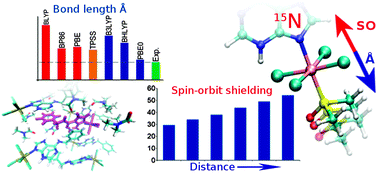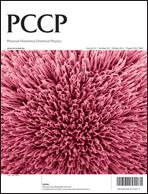A relativistic DFT methodology for calculating the structures and NMR chemical shifts of octahedral platinum and iridium complexes†
Abstract
A methodology for optimizing the geometry and calculating the NMR shielding constants is calibrated for octahedral complexes of Pt(IV) and Ir(III) with modified nucleic acid bases. The performance of seven different functionals (BLYP, B3LYP, BHLYP, BP86, TPSS, PBE, and PBE0) in optimizing the geometry of transition-metal complexes is evaluated using supramolecular clusters derived from X-ray data. The effects of the size of the basis set (ranging from SVP to QZVPP) and the dispersion correction (D3) on the interatomic distances are analyzed. When structural deviations and computational demands are employed as criteria for evaluating the optimizations of these clusters, the PBE0/def2-TZVPP/D3 approach provides excellent results. In the next step, the PBE0/def2-TZVPP approach is used with the continuum-like screening model (COSMO) to optimize the geometry of single molecules for the subsequent calculation of the NMR shielding constants in solution. The two-component zeroth-order regular approximation (SO-ZORA) is used to calculate the NMR shielding constants (PBE0/TZP/COSMO). The amount of exact exchange in the PBE0 functional is validated for the nuclear magnetic shieldings of atoms in the vicinity of heavy transition metals. For the PBE0/TZP/COSMO setup, an exact exchange of 40% is found to accurately reproduce the experimental NMR shielding constants for both types of complexes. Finally, the effect of the amount of exact exchange on the NMR shielding calculations (which is capable of compensating for the structural deficiencies) is analyzed for various molecular geometries (SCS-MP2, BHLYP, and PBE0) and the influence of a trans-substituent on the NMR chemical shift of


 Please wait while we load your content...
Please wait while we load your content...